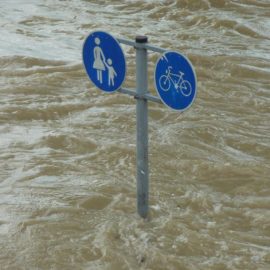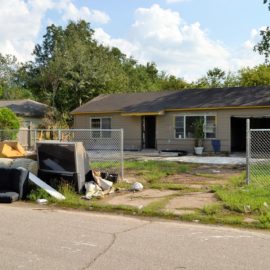
I have to start by saying my insurance dropped a lot and my sons did as well. He lived in Broadmoor and I am in uptown. Both of us are close to Napoleon.
Louisiana homeowners are projected to see a 122% percent increase in their flood premiums on average, phased in over multiple years, newly obtained data shows, under a remaking of the nation’s flood insurance program that has prompted deep concern from local officials. The figures are only projections, and could rise further due to the risks of climate change, including intensifying storms and sea-level rise. The data was obtained by The Times-Picayune | The Advocate from FEMA through a public records request. The agency, which oversees the National Flood Insurance Program, had previously refused to release the figures, providing only first-year increases under the new system, which masks the overall effects.
nola.com
18% is all it can go up which means many years of 18% increases, the more years the higher it goes up.
Premium increases are limited to 18% per year in most cases, and under the new system they will rise annually at that rate until the target rate, or “full risk premium,” is reached. New policies will be priced at the new rates immediately, however, and some residents have already expressed shock over the increases they’ve seen. The projected average full-risk premium for a single-family home in Louisiana under the new system, including fees and surcharges, amounts to $1,700 compared to $766 under the old system – a difference of 122%. Both the projection and the old premium are based on data from May 2020, FEMA says. Those living in particularly vulnerable areas are likely to be hit with even steeper hikes. Much of south Louisiana, given its proximity to water and low-lying topography, is at particular risk. For example, the FEMA data shows that Louisianans living an average of more than 100 miles from the coast at an average elevation of 37 feet will see the lowest rates. FEMA officials could not immediately say how the projected increase in insurance costs in flood-prone Louisiana compare with those of other states. Louisiana has had the nation’s highest participation rate in the NFIP, with about half a million policyholders.
This is the largest overhaul since the program was started and it is contested.
The overhaul marks the biggest change to flood insurance premiums since the program started in 1968. It is aimed at more accurately pricing risk by incorporating data from each individual home through a complex algorithm, abandoning the former system of relying largely on FEMA’s flood maps. FEMA says the new system will ultimately be fairer for all, noting that “if you are higher risk and higher value, you will pay more in flood insurance.” To help achieve that goal, the cost of repairing a home is a key factor in determining rates in the new system, aimed at ensuring higher-value houses pay their fair share. But local leaders fear the sweeping changes under what is known as Risk Rating 2.0 will reshape parts of the housing market in south Louisiana, potentially causing foreclosures or leaving working-class families unable to afford a home in areas where they have traditionally lived. “While we appreciate FEMA’s step towards transparency in releasing Louisiana’s full-risk rates, this data underscores our concerns about affordability and reaffirms the need for FEMA to address the weighting of each rating factor of Risk Rating 2.0,” said Michael Hecht, head of Greater New Orleans Inc., the regional economic development organization that has also established a national coalition on flood insurance.
The algorithm used is not understood and FEMA has been bad at explaining it.
FEMA has faced calls to provide further details on how its algorithm calculates risk through the new rating factors, which, in addition to replacement cost, include elevation and proximity to water, among others. The agency argues that rates also rose every year under the old system, and points out that around 20% of policyholders will actually see decreases under the new one. But increases in the old system averaged around 10% annually, according to FEMA, and the decreases under Risk Rating 2.0 will occur only once, in the first year. Beyond affordability, there have also been concerns over whether large numbers of people will drop out of the program because of the increases and be left without flood protection – and there are early signs that those fears could be borne out. Between June 2021 and June 2022, the latest figures available, the number of Louisiana flood policies in force dropped by 7.8%, while the country as a whole has seen a 9% decrease. Risk Rating 2.0 began taking effect for new policies in October, while existing policyholders began seeing the change with their first renewal starting in April. FEMA says the decrease in policies may have occurred for various reasons, including the economic effects of the pandemic, inflation and affordability, adding that “we remain confident that policies will increase, over time, under our new Risk Rating methodology.” An internal FEMA study, however, has estimated that nearly 20% of policyholders could drop out over a decade. The agency says it used “pessimistic assumptions” in that analysis.
It is being defended and all the complaints will have little impact as the rates have been set and the first bills are out.
During a visit to New Orleans last week, U.S. Homeland Security Secretary Alejandro Mayorkas defended the new system. “The rating system has a very strong foundation, and one of principle, which is the principle of equity … that the insurance that is distributed should not be distributed unequally and those with the greatest resources receive the greatest amount,” he said. “That is antithetical to the principle of equity for which we stand and which we are incorporating in all our policies and practices.” FEMA says the changes will end the practice of premiums for newer, pricier waterfront homes essentially being subsidized by those for older houses under the former system since the maps were such a crude tool for pricing risk. There is widespread agreement on that goal, but state leaders fear there will be severe unintended consequences for low-lying south Louisiana, where everyone lives near water of some kind.
Our congressional delegation has opposed the increases.
Louisiana’s congressional delegation has repeatedly called for further transparency in addition to issuing proposals to blunt the impact of the new rates. FEMA itself has proposed financial assistance for residents in need, but congressional approval is required for such a program. In a letter to the flood program’s senior executive last month, U.S. Sens. John Kennedy and Bill Cassidy of Louisiana joined colleagues from other Gulf Coast states in requesting further information. “A means tested assistance program cannot mitigate the severe future impacts that will befall those who have had grandfathered or steeply discounted premiums under the traditional premium structure,” the letter said. “In five to 10 years, we will start to see a sizable number of Americans who can’t afford to pay for NFIP under Risk Rating 2.0 and remain in their homes.”
FEMA hopes this will help put the system back into solvency.
The new system envisions the flood program setting actuarially sound rates, similar to the private sector. Doing so would help put the program, currently in debt to the tune of around $20 billion, on a path closer to solvency, though industry experts say catastrophic events will always cause deep budget shocks. As an example, the flooding following the federal levee failures during Hurricane Katrina led to more than $16 billion in paid claims. For that reason, there have been calls for wider reforms to the NFIP, including automatic debt cancellation following such catastrophic events.
This is something that we need down here. The increased and stronger storms can do more damage.



